
03/20/2011
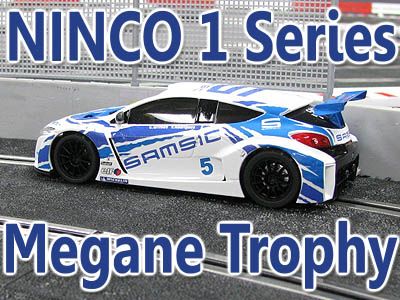
NINCO 1/32nd Scale N-Digital Megane Trophy - 2009 Samsic
By Kurt “ElSecundo” Moser
NINCO stays committed to the NINCO 1 line of cars with a new offering, the N-Digital Renault Megane Trophy ’09 “Samsic”. The real Megane Trophy car is a serious racing machine, complete with a tube chassis. Drivers are Caroline Grifnée and Vito Rodrigues.
Starting with the packaging, I have to admit that I’m not a big fan of the NINCO1 case. It certainly doesn’t have that collector-level ‘feel’ to it, but it does display well, with the car clearly displayed with no obstructions from an outer sleeve, and a clean view from top, side, front and back. I also do like that the car is held firmly in place by a rugged plastic screw, much better than NINCO’s traditional T-screw. What seems to be bugging me is that the car is framed in red, not so visually appealing. Like it or not, since the NINCO1 cars are more oriented to the track rather than shelf queen status, the case isn’t so important here, at least for me, anyway. It does what it needs to do well – it gets the car from A to B safely, and lets potential buyers get a good look at it.
When we get this baby away from its red case, though, we can really start to see the beauty of this car. Get it away from that red background, and the crisp blues contrast strikingly with a glossy and clean white paint. The white is offset nicely by the black, finned wheels.
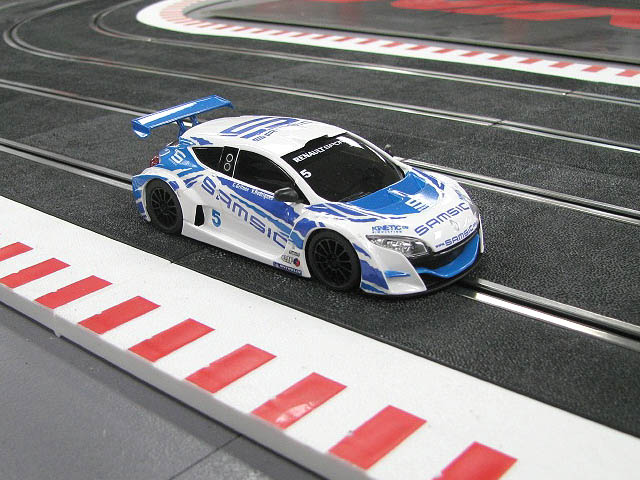
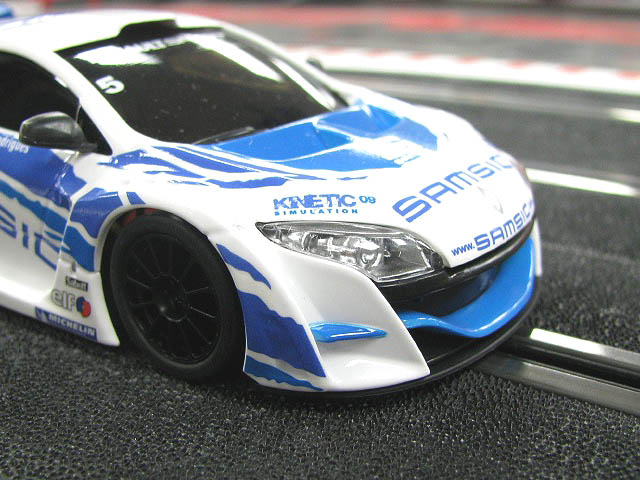
The dark tinted glass has painted detail on the windscreen, and absolutely nothing at first glance says “this is a car for beginners”. The execution is so nice, I hardly notice that there isn’t an interior. Comparing pictures and videos of Megane Trophy races on the internet confirms what a fine job NINCO did with the exterior, from the shape of the headlights to the flared wing endplates. Vented fenders front and rear provide detail, without taking away from the ruggedness of the car. NINCO toughens the car for racing with rubberized mirrors, and solid wing struts instead of the latticed affair used on the 1:1 car.
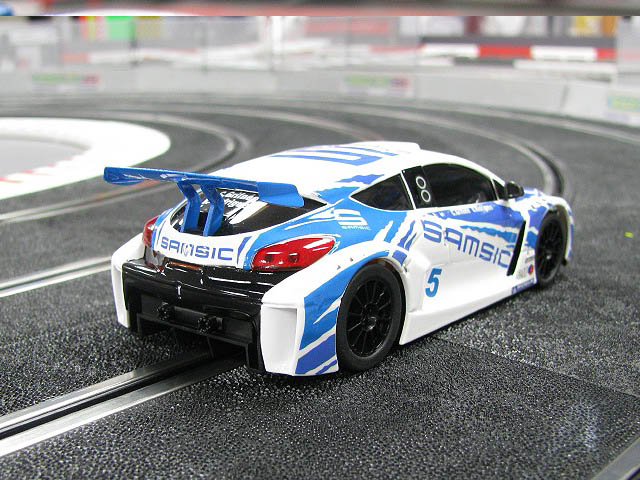
Some body detail is molded into the chassis, such as the front splitter and the tailpipes, adding to the durability of the car.
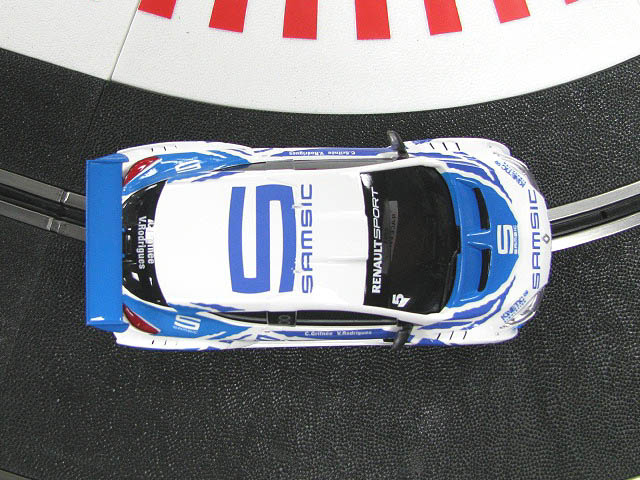
Inside, it’s all familiar NINCO1 fare, with the inline NC-11 motor, plastic gears and bushings, and lots of room for tuning. Instead of an interior, we get a red case containing the N-Digital chip, mounted unobtrusively in front of the motor. Lead wires are properly routed, and there is little slop in the bushings.
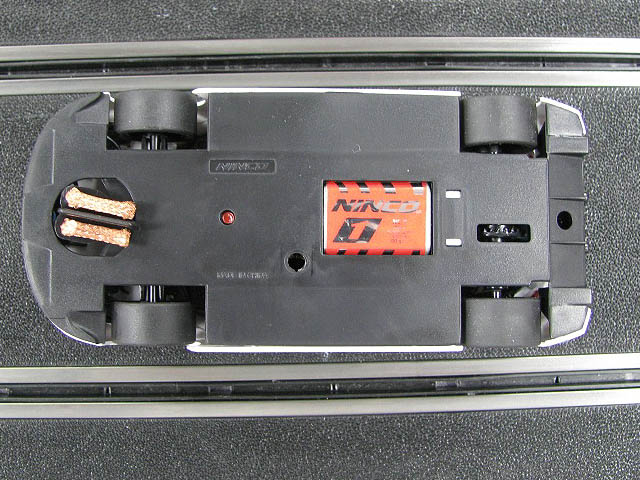
The front end is standard NINCO axle carriers molded into the chassis. Well, it’s happened before that the right car has been ruined by the wrong motor, either forcing a motor swap, or resulting in a car being left on the shelf. Not a problem here, as the NC-11 motor is ideal for a few purposes, whether it’s powering a beginner car, motivating digital cars on stock digital voltage, or for serious analog racing on stock voltage. A little sluggish at 11 or 12 volts, it comes alive with the N-Digital’s 14.0 volt 3-amp supply.
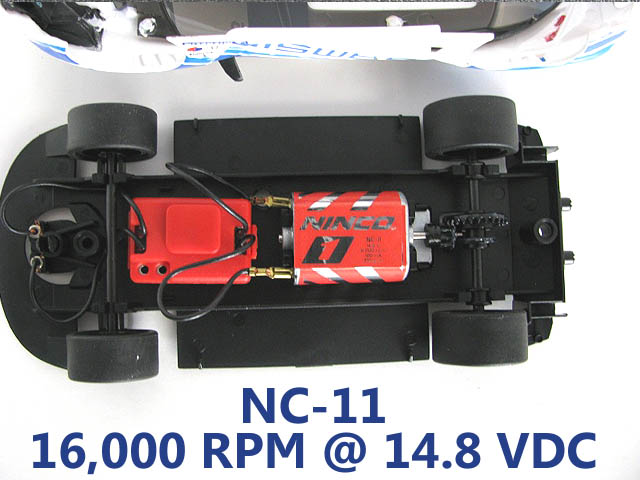
What’s become standard practice for all NINCO1 cars before getting track time is a braid/guide adjustment. The stiff braids necessitate removing the guide (you can leave the lead wires attached), slightly stretching the spring on the guide’s shaft, and flattening the braids to the guide as much as possible. This keeps the braids from lifting the light front end so far that the guide blade pops out of the slot. I’ve seen guys go from “Hey, this is junk!” to “Oh, is that all it takes?” in about 30 seconds. It’s very easy to do, but it has to be done.
My N-Digital track is currently unavailable due to work in the basement, but removing the chip is simple, and we’re back to analog running to see how the car performs. Our local hobby shop has a 4-lane analog NINCO track set up with stock power, and the car would get its shakedown there. Initially, we saw some bumpiness in the front end, but in short order, the abrasive NINCO track had taken the high spots off the tires, and we saw just how good this car can be with its little NINCO1 motor. Acceleration and top end were quite surprising, and the tires are very well suited to NINCO track. Between those tires and the stubby bar magnet, the Megane flew. Very quick, very easy to control. On stock power, it’s like driving with a punchy 20k motor. With no interior, the NC-11 has no trouble propelling the Megane with some real snap. Dial it back to 11 or 12 volts, and this car is the ideal beginner car – easy to drive, grippy, and forgiving.
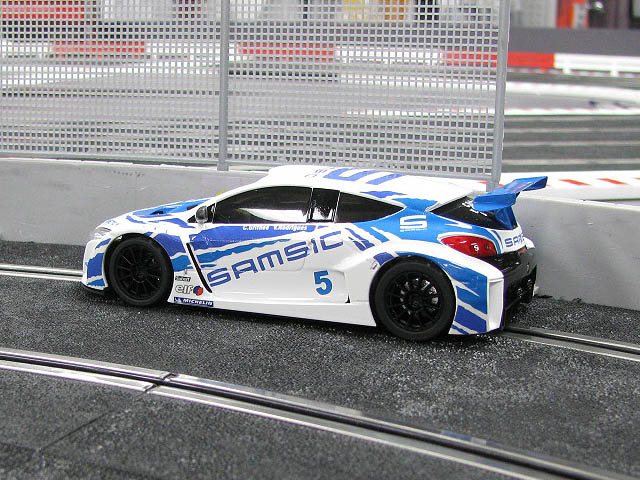
Are there drawbacks? Sure. The lack of an interior is troublesome for some hobbyists, as is the price. Suggested retail for the digital version is about 70 dollars US, and without the chip, it’s about 50. Is it worth it? I’d say it depends on what you’re doing with the hobby. I like the NINCO1 line as a ‘fleet’ car, the kind of car you keep -- one for each lane, for those spirited battles with friends, or for turning the kids loose. For N-Digital racing, they are perfect, not too fast or slow for the rapid digital action.
- Kurt
Thanks Go To MRC For Providing Us With This Sample!
Copyright © 2011 HomeRacingWorld.com All Rights Reserved